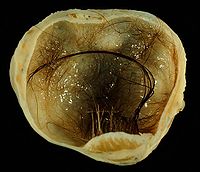
Photo from wikipedia
Almost 50% of children with intracranial ependymoma experience disease relapse, and their outcomes are extremely poor. The aim of this study was to investigate optimal salvage treatment for pediatric intracranial… Click to show full abstract
Almost 50% of children with intracranial ependymoma experience disease relapse, and their outcomes are extremely poor. The aim of this study was to investigate optimal salvage treatment for pediatric intracranial ependymoma after the first relapse and to identify prognostic factors affecting survival. We conducted a retrospective analysis of 159 children who underwent initial treatment for intracranial ependymoma at Beijing Tiantan Hospital from 2013 to 2017. Relapse was observed in 73 patients (73/159; 45.9%), with a median age of 7.2 ± 3.5 years old. Molecular subgrouping analysis identified H3K27me3-negative PF-EPNs in 74% of patients, ST-RELA EPNs in 21% of patients, and H3K27me3-positive PF-EPNs in 5% of patients. The 5-year event-free survival (EFS) and overall survival (OS) rates after first relapse were 21.1% (95% CI 16.0–26.2) and 30.5% (95% CI 19.8–30.8), respectively. Patients with GTR at first relapse had higher 5-year EFS and 5-year OS than those with STR (P = 0.031 and P = 0.003) or no surgery (P = 0.007 and P = 0.001). Radiotherapy or re-radiotherapy at first relapse significantly prolonged 5-year EFS and OS (both P < 0.001). Patients with H3K27me3-negative PF-EPN had worse 5-year EFS and OS than those with ST-RELA EPN (P = 0.001 and P = 0.002). Multivariate analysis showed that both tumor resection and radiotherapy at first relapse had independent prognostic significance for survival (all P < 0.05). Children with recurrent intracranial EPN have poor outcomes, and surgery and radiotherapy at first relapse should be encouraged to improve their prognosis.
Journal Title: Journal of Neuro-Oncology
Year Published: 2022
Link to full text (if available)
Share on Social Media: Sign Up to like & get
recommendations!